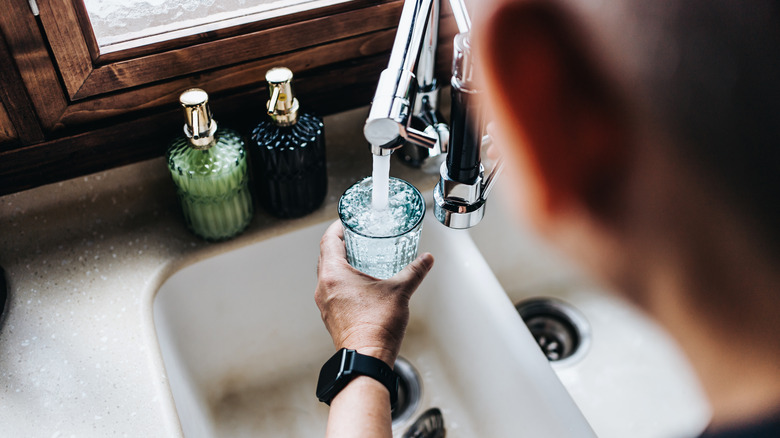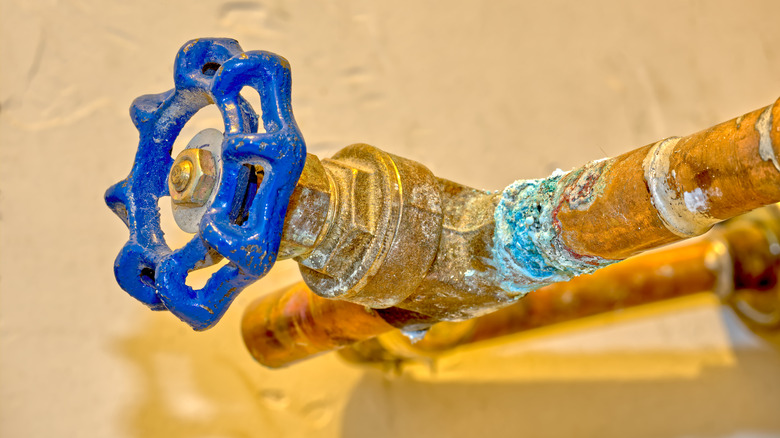The Concerning Reason Why Your Tap Water May Be Blue
Many people are used to relying on having clean tap water for drinking, cooking, and washing their hands without giving it a second thought. You may also keep tabs on the situation and want to look for effective ways to purify your household water. While public water is always regulated, occasional problems can still develop with water quality. If your water is possibly contaminated with either germs or chemicals, your utility company must notify you. Well water, while not regulated, can also be safe with regular testing. If any of your water smells or looks unusual, it's always best to err on the side of caution and have it tested. One rare, yet possible scenario, is seeing blue water flowing from your tap, which is most likely linked to a corrosion problem.
Sometimes poor water quality can develop outside of the water itself. One notable example is lead. Homes that have water pipes manufactured before 1986 are particularly vulnerable to harmful lead exposure in water. Copper corrosion in water pipes is another problem that can affect your drinking water. Unlike lead, which is invisible in water, copper corrosion can make tap water look blue or bluish-green. If you see water that appears any shade of blue, you should turn off your tap and avoid using any of it until you have pinpointed and resolved the exact problem.
How copper corrosion problems may turn your tap water blue
Aside from the color of the water, you may notice that your tap water leaves bluish stains on any white-colored sinks or bathtubs you might have in your home. In some cases, the water will only look blue when you run hot water out of the tap. If you accidentally drink the water, you will also notice that it has a metallic taste. Do not use any more water out of your tap if you suspect copper corrosion. While copper poisoning is uncommon, toxicity from the mineral can still lead to serious health problems, such as kidney and liver injury.
Copper pipes can corrode in a home over time, but there are also a few specific causes of corrosion and blue water to consider. First, if you're only seeing blue water while running hot water, this can indicate an issue with your home's hot water system. Your water might be set at too high a temperature, or there may be issues with the pipe sizes or circulation system. Also, if your pipes are made with a combination of copper and iron materials, the corrosion may be attributed to your home's electrical system grounded to water pipes. Such a scenario is more common in older homes. In newer buildings, copper corrosion can happen due to poor installation. In any of these cases, you should consider reaching out to an expert for help, especially if the water continues to run blue despite lowering the temperature on your hot water tank. These are all signs you need to call a plumber for your kitchen or bathroom.
Certain chemical leaks can also lead to blue tap water
Aside from copper corrosion, there's yet another possible reason why your tap water might be blue: toilet disinfectant. It might seem unbelievable that the blue disinfectant you use to clean your toilet could get into your tap water. While also rare, it's thought that this can happen when water from within the toilet tank siphons into the rest of your home's plumbing system. This may occur when your home's water supply is turned off.
If your tap water is indeed running blue, and your water was recently turned off, contamination from any blue-colored toilet disinfectants you use may be a real possibility here. You should not use this water under any circumstances. As a precaution, turn on all of your home's water taps until they run clear again to help flush out the contaminated water. You can also consider some of the best water testing kits to ensure safe drinking at home if you're unsure whether your tap is in the clear.


